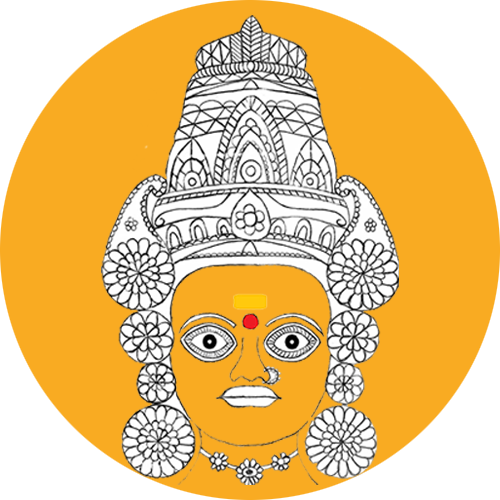Honagunta Place Significance
Honagunta (Hunugunti) Shree Chandralaparmeshwari Tirth Kshetra is located on the confluence of the magnificent Kagina (Kakini) and Bhima (Bhimarathi) River. As per Skanda purana Honagaunta Kshetra Varnana as follows (Place Description):
After the birth of God Kartikeya, his umbilical cord (Hiranmayi nala) fell on Sumeru Parvatha and a plant started growing. When this plant came in contact with holy water of River Ganga, it started emitting a pleasant fragrance. Since Devi Parvati liked this plant, she planted it in Kailash. Since then, this plant has been known as “Haridra” (Turmeric).
During the churning of Kshirsagar (Samudra Manthana) DevAsuras added all the divine herbs to Kshirsagar (Milk Ocean). They used Mandar Parvatha as a churning stick and Serpent King Vasuki as a rope. After some time, a poison called Kalakuta was produced from the ocean. Due to its extremely potent nature that could destroy the world, DevAsuras begged Shiva to swallow it.

Despite the continued churning, they were unable to acquire the Amruth. Lord Brahma advised the DevAsuras to add Haridra to Kshirsagar and churn. The DevAsuras obtained the Haridra from God Shiva and Goddess Parvati and added it to Kshirsagar. After that they continued churning and produced Amruth, Kamadhenu, Kalpavriksha, Airavat and Goddess Lakshmi.
Due to the receding Kshirsagar waves, the splendor and fragrance of Haridra multiplied. Lord Vishnu ordered Garuda to drop the Haridra mula (origin of Haridra) in all Tirthas of Triloka. As ordered by Lord Vishnu Garuda went to Pathal-loka and dropped the Haridra mula into river Bhogavati. Bhagavati Elamba who was staying in Pathal-loka liked the fragrance and asked Yoginis to find the Haridra mula. A Yogini named Kakini found the Haridra mula and swallowed it. To avoid Bhagavati Elamba, Kakini hide in Bhuloka. When Bhagavati Elamba came to know about Kakini’s deceit, she cursed her to become water. Kakini became water and started flowing which caused the Haridra Mula that she swallowed to float. When Kakini confluence with Bhimarathi river, Haridra mula became free from all its coverings causing its fragrance to spread far and wide. Jagadamba Bhramari Devi who was residing at the confluence of Kakini and Bhimarathi river was attracted by the Haridra mula, and she summoned God Shiva. Upon arrival, God Shiva rubbed the Haridra mula against a stone and applied the paste produced to the cheeks of Jagadamba Bhramari Devi. This gave the place its name Honu Dvaya Gunthaya (Honugunta/Hongunta) from Sanskrit: Honu means cheek, Dvaya means two and Gunthaya means to apply.
Jagadamba Bhramari Devi then applied the Haridra paste on Lord Shiva as well. All the Devi and Devatas arrived and applied the Haridra on each other while appreciating its divinity and serenity. From this day onwards, Haridra became the divine herb for all gods and goddesses. It also became Sumangala dravya for Suhasinis and was used in all Mangal karya.
Kakini prayed to Goddess Mahalakshmi and requested that she be released from the curse. With acceptance from Bhagavati Elamba, goddess Mahalakshmi granted a boon to Kakini to flow as a river and whoever touches her water will be purified by all sins and attain moksha and in another form, she will get her yogini roopa back and stay with Bhagavati Elamba at Honugunta. She also decreed that anyone who worships or performs Japa and Tapa of Devi at Honugunta will get blessings equal to a thousand times. Visiting Honugunta will cleanse a lifetime of sins.


